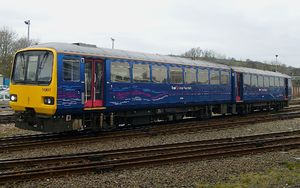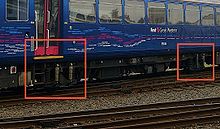- British Rail Class 143
-
British Rail Class 143 Pacer
A First Great Western Class 143 Pacer No. 143617 at Exeter TMD, opposite Exeter St. Davids Station. This was the first one to be refurbished for First Great Western.
The interior of a First Great Western refurbished Class 143In service 1985 - present Manufacturer Hunslet-Barclay and Walter Alexander Family name Pacer Number built 25 trainsets Number in service 23 trainsets Number scrapped 2 trainsets Formation 2 cars per trainset Capacity 106 seats Operator Arriva Trains Wales
First Great WesternLine(s) served Avocet Line, Bristol to Taunton Line, Riviera Line, Severn Beach Line
Tarka Line and Valley LinesSpecifications Car body construction Steel underframe. Aluminium alloy body and roof. Car length 15.2 metres (49 ft 10 in) Width 2.7 metres (8 ft 10 in) Maximum speed 75 mph (121 km/h) Weight 26.3 tonnes (25.9 long tons; 29.0 short tons) Engine(s) Cummins LTA10-R of 225 hp (168 kW) at 1950rpm[1]
(Originally fitted with Leyland TL11 6 cylinder 11.1 litre 205 hp (153 kW) at 1950rpm)Safety system(s) AWS, TPWS Coupling system BSI[2] Gauge 1,435 mm (4 ft 8 1⁄2 in) Standard gauge The British Rail Class 143 is a diesel multiple unit, part of the Pacer family of trains introduced between 1985 and 1986. They originally worked in the North-East of England but were later transferred to Wales and South-West England.[3]
Under the Disability Discrimination Act drawn up in the mid 1990s, all public transport will need to be accessible by 2019. Pacers are unable to meet this requirement so will have to be withdrawn by the end of 2019. [4]
Contents
Technical
At around the same time of the British Rail Class 142 development, a Pacer railbus was being developed by Kilmarnock-based Hunslet-Barclay. The train used a Walter Alexander bus body and entered service in 1985. Again with 2 × 205 bhp (153 kW) motors giving a total output of 410 bhp (306 kW) and a top speed of 75 mph (121 km/h), the class originally had a capacity of 122 passengers per 2 coach unit.[citation needed]
Twenty-five units were built, numbered 143001-025, originally deployed in North-East England. 143001-019 were supplied in Provincial railbus-style two-tone blue livery, and 143020-025 were supplied in Tyne & Wear PTE yellow+white livery. In 1989, Heaton depot (Newcastle) implemented a unit renumbering scheme, whereby those with original SCG mechanical transmission would be renumbered 1433XX, and those that had undergone conversion to Voith hydraulic transmission would be renumbered 1436XX. By this time, many units had already received Voith transmission, so were renumbered directly from 1430XX to 1436XX. Only the T&WPTE-sponsored units - which received Voith transmission later on - actually carried the 1433XX series, renumbered to 1436XX when they were eventually converted.
As with all Pacer units, the 2 axle non articulated wheel arrangement has given rise to problems with wheel noise on low radius curves and poor ride quality in general.[citation needed] The interiors were completely changed in 2000, with bespoke Chapman, high back seating installed throughout, along with improved fittings replacing 2+3 bus style low back seating; this reduced seating capacity to 106 seats per set.[citation needed]
Operations
North East
The class was based at Heaton depot (Newcastle) from new, for use throughout the North East of England. As with class 142, problems soon emerged with the SCG mechanical transmission, resulting in poor availability, and frequent loco-hauled substitutions on local services, especially in 1987, continuing to a lesser extent in 1988 and 1989 as the units were progressively fitted with the more suitable Voith hydraulic transmissions. Improved availability of the class enabled the Class 101s to be withdrawn from the region in 1989, by which time the loco-hauled substitutions had also dwindled to typically one set diagram per day, finally petering out in Summer 1990 as the Pacers generally settled down to give more acceptable reliability.
During the problems, a total of four original formations were split, and reformed to make operational DMS-DMS(L) sets, in a bid to alleviate the acute DMU shortage in the region. First to be split were 143002 and 143010, and cars 55643+55676 actually carried unit no. 143026 for a time in 1988. However, the pair was later renumbered 143010. The other cars 55651+55668 appeared later in 1988, with 55651 having a large white number 2 - meant for coach sides - crudely placed across the black 10 of its original unit number, only rectified upon renumbering to 143602. 143003 had spent a lengthy spell out of action with fire damage, then in Summer 1989, car 55644 from it was paired with 55683 (ex-143617), and both given the unit number 143617. The other cars 55658+55669 re-appeared later that Summer, both carrying unit number 143603. These reformations were never reversed to original formations, thus 143602, 143603, 143610 and 143617 remained mis-formed ever since. 143025 did carry the name of 'River Tyne' for sometime when it was based in the North East
Wales
From 1991/92, the units started to be transferred to Cardiff Canton depot for operations in South Wales, and moved over to Wales & West control during privatisation.[citation needed] It then passed on to Wessex Trains, which became part of the Great Western franchise.[citation needed] Arriva Trains Wales use their Class 142 trains on the commuter lines around Cardiff to places such as Rhymney, Aberdare and Barry Island. Additionally, Arriva have deployed 143s on longer journeys, such as those from Cardiff Central to Carmarthen, Swansea, Pembroke Dock and Fishguard Harbour.
They operate 15 sets, a 16th set (143615) sustained severe fire damage during 2005[citation needed] and has now been scrapped at Cardiff Canton.[citation needed] Arriva's fleet were repainted in turquoise and cream Arriva Trains Wales livery. 143609 has been named 'Sir Tom Jones' in honour of the Welsh singer.[5]
Arriva Trains Wales commenced a minor interior refresh of their Class 143 in Autumn 2009.[citation needed] The seats are being retrimmed into the Arriva moquette.[citation needed] Additionally on the exterior of the Class 143 Pacer trains, LED head and rear marker lights and LED door obstruction marker lights are being installed.[citation needed]
South-West England
Wessex Trains used their fleet primarily on commuter services around Bristol, although towards the end of the franchises they were increasingly on longer distance Cardiff to Taunton services.[citation needed] They were occasionally used on rural branch lines but this was generally avoided where possible due to problems with wheel wear and the noise on sharp corners.[citation needed]
First Great Western inherited the seven Wessex Trains units when the franchises were merged in April 2006. An eighth set used by Wessex (143613) caught fire near Nailsea and Backwell[6] in October 2004 and has since been broken up at Cardiff Canton.[citation needed]
In Autumn 2008, the Class 143s began a further refurbishment program at Eastleigh works;[citation needed] the interior improvements include:
- New 'easy to clean' flooring[citation needed]
- A retrim of the existing Chapman seats with First Great Western moquette[citation needed]
- Refurbished toilet area with new flooring, wall coverings, toilet and sink basin[citation needed]
- Brighter interior saloon fluorescent lighting diffusers[citation needed]
Since December 2008 the Class 143s are based at Exeter TMD alongside seven similar Class 142s. They are now allocated to the following services:[citation needed]
- Avocet Line Exmouth - Exeter St. Davids
- Riviera Line Exeter St. Davids - Newton Abbot - Paignton
- Severn Beach Line Bristol Temple Meads - Avonmouth - Severn Beach
- Tarka Line Barnstaple - Exeter St. Davids
Liveries and interiors
-
Arriva Trains Wales 143616 at Hengoed with a service to Penarth
Fleet details
Operator No. of units Unit nos. Notes Arriva Trains Wales 15 143601/602/604-610/614/616/622-625 143615 withdrawn after a fire First Great Western 8 143603/611/612/617-621 143613 withdrawn after a fire References
- ^ Diesel Multiple Units 2010. Platform 5. 2010. p. 14. ISBN 978 1902 336 75 6.
- ^ "System Data for Mechanical and Electrical Coupling of Rail Vehicles". Rail Safety and Standards Board. http://www.rssb.co.uk/rv_coupling_system_data/list_index.asp. Retrieved 2009-01-05.[dead link]
- ^ "TheRailwayCentre - Class 143". http://www.therailwaycentre.com/Pages%20DMU/Recognition%20DMU/IllusDMU_143.html.
- ^ http://www.gmita.gov.uk/download/3203/item_08_response_to_the_rail_franchising_consultation
- ^ Fleet lists Class 143 thejunction.org
- ^ "Commuters escape from train blaze". BBC News. October 19, 2004. http://news.bbc.co.uk/1/hi/england/bristol/3754902.stm.
Diesel multiple units of the United Kingdom First generation units: First Generation
Original TOPS:First generation units
(pre-TOPS):British United Traction · Derby Lightweight · Metro-Cammell · Railbus · GWR Railcars · LMS Railcars
Second generation units: Diesel-electric units: Southern Railway designations: Families Categories:- British Rail diesel multiple units
Wikimedia Foundation. 2010.











